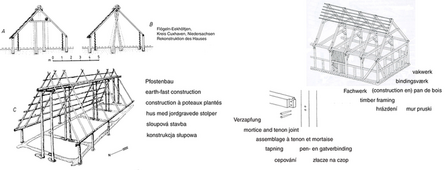Multilingual Glossary of Prehistoric and Historic Timber Buildings
A substantial proportion of preindustrial architecture in Europe was dominated by timber construction, forming the focus of research for various scientific disciplines, for instance archaeology, building archaeology as pursued by art historians and architects, or “historical house research” in ethnology. Precise description of these timber constructions requires a complex and highly specialised terminology. There are differences in the understanding of terminological definitions between the various scientific disciplines, and it is not even unusual for researchers of the same discipline but working in different regions of the same country to use different terminology when addressing the same topic. It is evident that communication on an international level is particularly prone to be hampered by different terminology and differing understanding of terms and definitions.
The “Glossary of Prehistoric and Historic Timber Buildings” tries to define the individual phenomena of timber construction, describe the specialist terminologies of various languages and explain how they relate to one another. The glossary’s subject matter is confined to the everyday object “house” and thus the field of wooden architecture, which is numerically the most significant in the stock of preserved buildings. It gathers terminology from all subject matters relating to timber buildings: starting with woodworking, its tools and working techniques, it comprises structural elements of roof and wall constructions, timber joints as well as functional types and areas, as long as they relate to established timber building. By contrast, neither specialist areas of timber building nor dialect- and non-specialist terminology has been included.
The glossary’s structure is that of a compilation of terminology. In contrast to a dictionary, the basis for a translation into the various target languages is not a word of a starting language but instead an independent definition. The description for a term defined in this way is then researched for the individual languages. These definitions, some of which had to be developed from scratch, can also be at variance to those commonly used in the individual countries; they are closely linked to specialist discussion, especially in the case of more complex concepts.
The project had been carried out at the NIhK between 2004 and 2010. It was initially coordinated by Ulrike Oltmans, succeeded by L. Vollmer from 2007 onwards. The project was funded by the EWE-Foundation and the Gertrud and Hellmut Barthel-Foundation, Varel.
Bibliography
Volmer, L. (2007): Glossar zum prähistorischen und historischen Holzbau. Ein Projekt am Niedersächsischen Institut für historische Küstenforschung in Wilhelmshaven. In: AHF-Mitteilungen 71, August 2007, 10-13
Lutz Volmer und Wolf Haio Zimmermann (Hrsg.), 2012: Glossar zum prähistorischen und historischen Holzbau. Französisch, Englisch, Niederländisch, Deutsch, Dänisch, Norwegisch, Schwedisch, Polnisch und Tschechisch. Studien zur Landschafts- und Siedlungsgeschichte im südlichen Nordseegebiet 3. Rahden/Westf.


